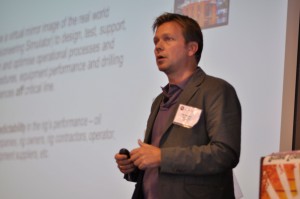Rig-specific simulation process targets drilling optimization
By Katie Mazerov, contributing editor
Aker Solutions has developed a concept called “visioneering” that uses the industrial gaming principles of advanced visualization and simulation to reduce risk and improve rig performance.

The process uses a virtual mirror image of the real world to design, test, support, train and optimize operational processes and procedures, equipment performance and drilling sequences off the critical line, said Ole Paulsen, vice president for Aker’ Performance Technology Center. Mr Paulsen and Bjarne Larsen, global manager, Performance for Aker Solutions, described the concept in a presentation at the IADC Advanced Rig Technology Conference & Exhibition on 20 September in Houston.
“In order to improve the performance of the rig operation, we have to continually see operational excellence through the entire integrated drilling cycle – topside, subsea and well – from planning through training, operational monitoring and support to post-operational analysis and continuous operational improvements,” Mr Paulsen said.
The simulator, which is rig- and well-specific, is a one-to-one copy of the actual rig. “This is a process that traditionally has been done on critical line, which can result a lot of nonproductive time,” Mr Paulsen said. “We’re trying to increase predictability.” The simulator includes all parts of the drilling process, the equipment challenges and the control systems in an environment where people from different disciplines and backgrounds can see an exact picture of what is going on.
The simulation process is used for planning and topside verification to determine if equipment needs overhauling or if control systems need to be changed. It has been used to align crew performance, optimize control systems and operational procedures and provide multidiscipline operational training. Concept verifications, integrated training, a test facility and integrated planning and support have been developed for the topside. Integrated training, planning and support have been designed for the blowout preventers (BOP) and the well.
“Once we have the technology in place, we connect to the rig with operational crews to analyze the current challenges and performance on both the rig and the well before we build the one-to-one simulator,” Mr Paulsen explained. “Then we build the simulator and start the drilling optimization project to confirm the analysis and current challenges.”
The virtual rig is constructed from as-built drawings, then laser-scanned and connected to a control system. The inside of the drilling equipment is constructed exactly as it is in the real world. Geology and well data also are imported. “We follow the rig’s changes and improvements, record it, take it back into the simulator and bring in engineers to verify that it is one-to-one with the real world,” he said.
Improving operational performance
The human factor plays a significant role in varying performance. “We have found that two crews on the same rig with presumably the same training perform completely differently,” Mr Paulsen continued. “For example, on tripping, we have seen a difference of 500 meters per hour on the same rig, with the same conditions from one crew to the other.”
On one rig that had been operating since 2001 with the same crews, the client was considering replacing and upgrading the equipment to improve tripping speed. The simulator, however, determined that a training program focusing on operational procedures with the crews trained on the new procedures was necessary. The combination of some new equipment and the new procedures with crews improved tripping time significantly.
“When it comes to testing, time spent in a simulator saves time during commissioning, which is essential on an operating rig,” Mr Larsen said. “In this case, the return on investment for the client was less than six months.”
Aker Solutions has successfully installed one-to-one simulators rigs in Houston, Norway, Germany, Italy, South Korea, Singapore and Macaé, Brazil.
“Our goal is to make sure we get the right things done right the first time, every time, all the time,” Mr Paulsen said. “No system will survive bad use of the system.”




